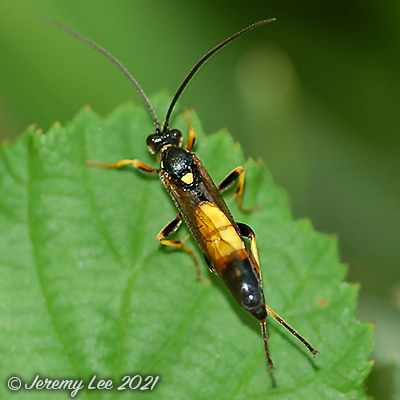
 |
|
Scientific Classifications explained » Amphibians » Ants » Aphids » Bees » Beetles » Birds » Bugs » Butterflies » Caterpillars » Damselflies » Dragonflies » Earwigs » Flies » Frog/Leafhoppers » Fungi » Galls » Grasshoppers » Harvestmen » Hoverflies » Lacewings » Ladybirds » Leaf Mines » Lichens » Mammals » Millipedes » Mosses » Moths » Sawflies » Slugs » Snails » Spiders » Trees & Shrubs » Wasps » Wild Flowers » Woodlice » Postboxes |
UK Nature > Wasps > Amblyteles armatorius

Scientific Name: Amblyteles armatorius Common Name: Ichneumon Wasp Amblyteles armatorius is one of the larger and more attractively marked ichneumonidae, approximately 15mm in length, excluding antennae. A parasitic wasp, it does not possess a sting, and is therefore harmless to humans. The strong yellow and black markings most likely make it a Batesian mimic; a form of protective mimicry in which an unprotected species closely resembles an unpalatable or harmful species and therefore is similarly avoided by predators. Very often found in summer on flowers feeding on pollen, especially umbellifers such as Hogweed. Found almost everywhere in lowland Britain on roadside verges, hedgerows, woodland rides and clearings, especially on any dense undergrowth such as bramble patches. |
|

https://www.uknature.co.uk is a website dedicated to showing the immense diversity of UK nature and wildlife. Our vast range of habitats, from lowland arable to snow covered mountains, from storm-ravaged coastlines to peaceful inland freshwater lakes and rivers, from dry, sandy heaths to deciduous and coniferous forests, all these habitats contribute to the abundance of UK nature. We have wild birds in huge numbers either residing or visiting our shores (597 recorded species as at July 2013) and we must also not forget the humble back garden with its grass lawns, flower beds filled with nectar rich flowers, shrubs and trees, all designed to attract huge numbers of insects such as bees, moths, butterflies and hoverflies; and finally the small ponds which provide safe havens for frogs, toads, newts and even slow worms and grass snakes. www.uknature.co.uk is the showcase for my personal passion, photographing uknature in all its glory. I sincerely hope you all enjoy the fruits of my labours. This site and all images contained therein is © Jeremy Lee 2004 - 2025. All Rights Reserved. Site design by Jeremy Lee. Site development & IT Support by Stuart Lee. |